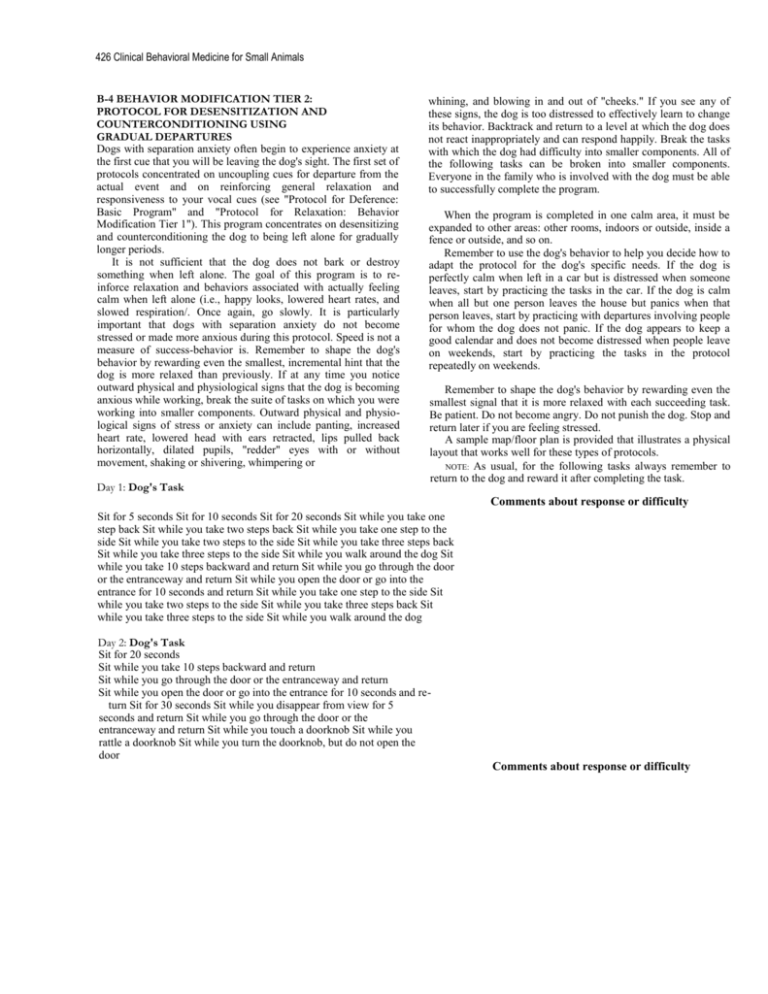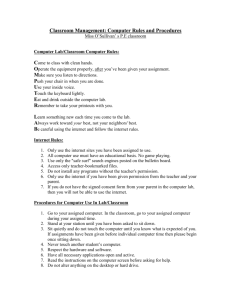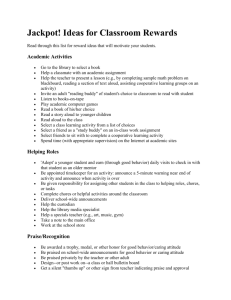426 Clinical Behavioral Medicine for Small Animals
advertisement

426 Clinical Behavioral Medicine for Small Animals B-4 BEHAVIOR MODIFICATION TIER 2: PROTOCOL FOR DESENSITIZATION AND COUNTERCONDITIONING USING GRADUAL DEPARTURES Dogs with separation anxiety often begin to experience anxiety at the first cue that you will be leaving the dog's sight. The first set of protocols concentrated on uncoupling cues for departure from the actual event and on reinforcing general relaxation and responsiveness to your vocal cues (see "Protocol for Deference: Basic Program" and "Protocol for Relaxation: Behavior Modification Tier 1"). This program concentrates on desensitizing and counterconditioning the dog to being left alone for gradually longer periods. It is not sufficient that the dog does not bark or destroy something when left alone. The goal of this program is to reinforce relaxation and behaviors associated with actually feeling calm when left alone (i.e., happy looks, lowered heart rates, and slowed respiration/. Once again, go slowly. It is particularly important that dogs with separation anxiety do not become stressed or made more anxious during this protocol. Speed is not a measure of success-behavior is. Remember to shape the dog's behavior by rewarding even the smallest, incremental hint that the dog is more relaxed than previously. If at any time you notice outward physical and physiological signs that the dog is becoming anxious while working, break the suite of tasks on which you were working into smaller components. Outward physical and physiological signs of stress or anxiety can include panting, increased heart rate, lowered head with ears retracted, lips pulled back horizontally, dilated pupils, "redder" eyes with or without movement, shaking or shivering, whimpering or Day 1: Dog's Task whining, and blowing in and out of "cheeks." If you see any of these signs, the dog is too distressed to effectively learn to change its behavior. Backtrack and return to a level at which the dog does not react inappropriately and can respond happily. Break the tasks with which the dog had difficulty into smaller components. All of the following tasks can be broken into smaller components. Everyone in the family who is involved with the dog must be able to successfully complete the program. When the program is completed in one calm area, it must be expanded to other areas: other rooms, indoors or outside, inside a fence or outside, and so on. Remember to use the dog's behavior to help you decide how to adapt the protocol for the dog's specific needs. If the dog is perfectly calm when left in a car but is distressed when someone leaves, start by practicing the tasks in the car. If the dog is calm when all but one person leaves the house but panics when that person leaves, start by practicing with departures involving people for whom the dog does not panic. If the dog appears to keep a good calendar and does not become distressed when people leave on weekends, start by practicing the tasks in the protocol repeatedly on weekends. Remember to shape the dog's behavior by rewarding even the smallest signal that it is more relaxed with each succeeding task. Be patient. Do not become angry. Do not punish the dog. Stop and return later if you are feeling stressed. A sample map/floor plan is provided that illustrates a physical layout that works well for these types of protocols. NOTE: As usual, for the following tasks always remember to return to the dog and reward it after completing the task. Comments about response or difficulty Sit for 5 seconds Sit for 10 seconds Sit for 20 seconds Sit while you take one step back Sit while you take two steps back Sit while you take one step to the side Sit while you take two steps to the side Sit while you take three steps back Sit while you take three steps to the side Sit while you walk around the dog Sit while you take 10 steps backward and return Sit while you go through the door or the entranceway and return Sit while you open the door or go into the entrance for 10 seconds and return Sit while you take one step to the side Sit while you take two steps to the side Sit while you take three steps back Sit while you take three steps to the side Sit while you walk around the dog Day 2: Dog's Task Sit for 20 seconds Sit while you take 10 steps backward and return Sit while you go through the door or the entranceway and return Sit while you open the door or go into the entrance for 10 seconds and return Sit for 30 seconds Sit while you disappear from view for 5 seconds and return Sit while you go through the door or the entranceway and return Sit while you touch a doorknob Sit while you rattle a doorknob Sit while you turn the doorknob, but do not open the door Comments about response or difficulty 11 Sit while you touch a doorknob Sit while you rattle a doorknob Sit while you turn the doorknob, but do not open the door Sit while you open the door a few centimeters and quickly close it Sit while you open the door 0.25 meters and then close it Sit while you open the door 0.5 meters and then close it Sit while you walk back 10 steps Sit while you rattle the doorknob Sit while you open the door 0.5 meters and then close it Sit while you open the door 1 meter and then close it Sit while you step into the door but remain in view Day 3: Dog's Task Sit while you turn the doorknob, but do not open the door Sit while you open the door a few centimeters and quickly close it Sit while you open the door 0.5 meters and then close it Sit while you open the door 1 meter and then close it Sit while you step into the door but remain in view Sit while you step into the doorway Sit while you step through the doorway Sit while you step through the doorway, close the door just slightly, and immediately return Sit while you step through the doorway, close the door, wait 5 seconds, and return Sit while you disappear from view for 10 seconds and return Sit while you disappear from view for 15 seconds and return Sit for 10 seconds Sit for 15 seconds Sit while you disappear from view for 15 seconds and return Sit while you step through the doorway, close the door, wait 10 seconds, and return Sit while you step through the doorway, close the door, wait 20 seconds, and return Sit while you go out of the door and firmly close it Sit for 20 seconds Sit for 10 seconds Sit for 5 seconds Comments about response or difficulty Day 4: Dog's Task Sit for 10 seconds Sit while you go out of the door and close it: and wait 5 seconds and wait 30 seconds and wait 45 seconds and wait 90 seconds and wait 2 minutes Sit while you go out of the door and close it: and wait 3 minutes and wait 4 minutes and wait 5 minutes and wait 7 minutes and wait 10 minutes Comments about response or difficulty Continue as above until the dog can sit quietly and relax while left alone for 30 minutes. Generally, if the dog can be relaxed while left alone for 30 minutes, the dog will be able to relax when left alone for normal durations, prohibiting any startling or disastrous consequences. This means that if your dog is afraid of thunderstorms and one occurs while it is left alone, relapse is possible. Treat all of the problems. For Future Repetitions • Repeat all tasks in different locations. • Repeat all tasks with all family members. • Repeat all tasks with only every second or third task being rewarded with a treat. (Remember praise! • Repeat with only intermittent treat reinforcement. (Remember praise! Antianxiety medications may help some dogs that otherwise are unable to succeed in this program. Remember, if it is decided that medication could benefit your dog, you need to use it in addition to the behavior modification, not instead of it.1 From K. Overall, Clinical Behavior Medicine for Small Animals, with permission. Veterinary Care Center at Goldens Bridge 232-8800







